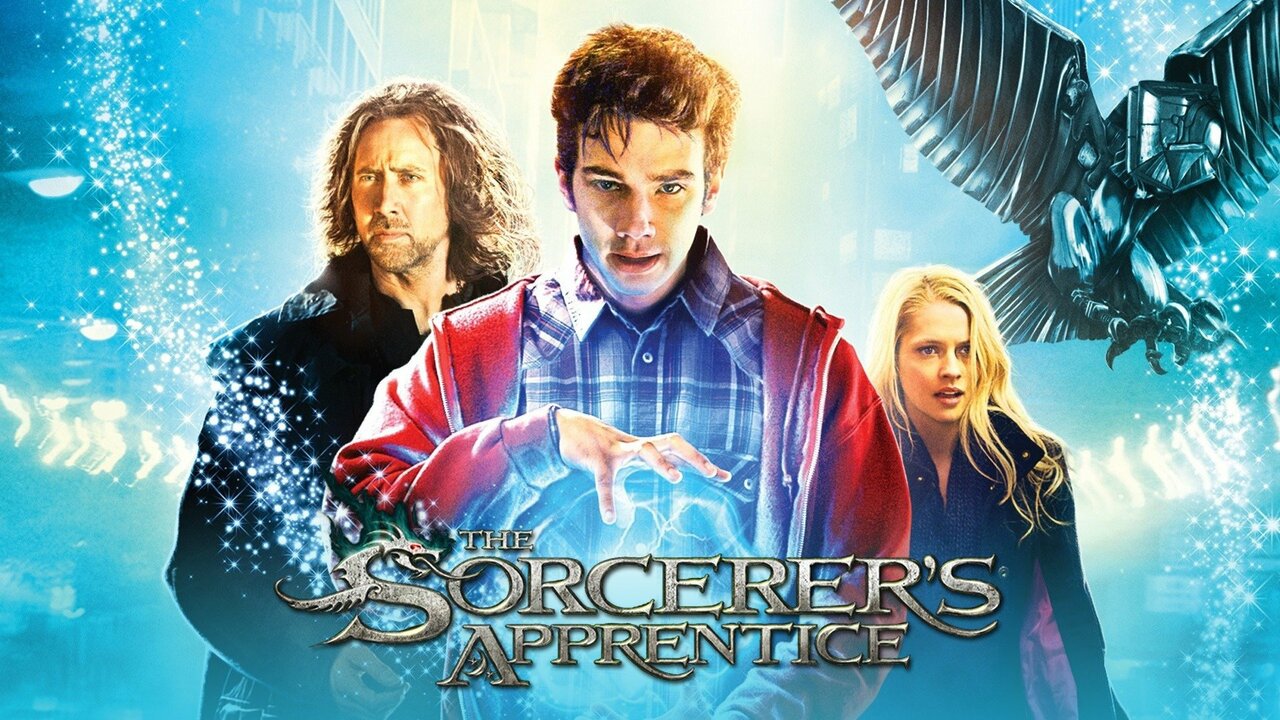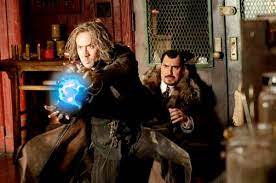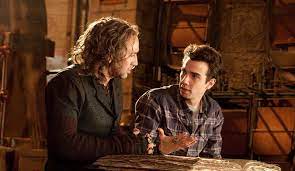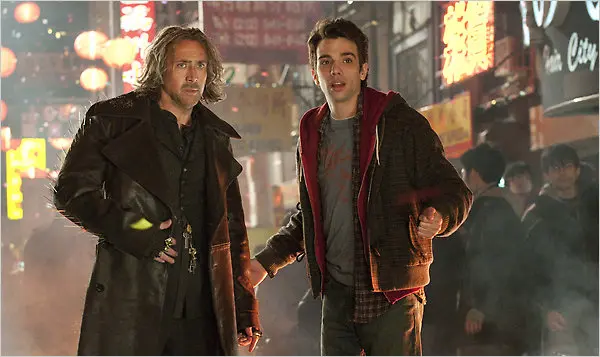The Sorcerer’s Apprentice (2010)

The Sorcerer’s Apprentice (2010) – A Detailed Review
The Sorcerer’s Apprentice, directed by Jon Turteltaub and released in 2010, is a modern fantasy adventure film that aims to blend magical spectacle, humor, romance, and action into a family-friendly package. The story centers on Dave Stutler, an ordinary physics student who discovers that his mundane life is about to change in the most extraordinary way possible. Through a series of extraordinary events, he becomes the apprentice of the legendary sorcerer Balthazar Blake and finds himself embroiled in a battle between ancient magical forces that will determine the fate of the world.
The film opens with a historical backdrop, showcasing a younger Balthazar Blake battling the dark sorceress Morgana le Fay. This prologue sets the tone for the conflict that has persisted for centuries, grounding the narrative in a rich magical history. The action is immediate and visually impressive, providing a taste of the fantastical elements that will permeate the story. The opening scenes establish the stakes and give audiences a glimpse of the power and danger inherent in the magical world that Balthazar inhabits.
The story then transitions to the present day, where Dave Stutler is introduced as a brilliant but socially awkward physics student. Nicolas Cage portrays Balthazar Blake, a character whose eccentricities and mystical presence dominate every scene he is in. Cage brings a unique energy to the role, balancing the wisdom of a centuries-old sorcerer with a playful, almost whimsical sense of humor. His performance anchors the film and provides a mentor figure for Dave, creating a dynamic relationship that drives much of the narrative forward.
Jay Baruchel plays Dave Stutler, the titular apprentice, who is thrust into a world far beyond his comprehension. Baruchel’s performance captures the mixture of awe, fear, and determination that defines Dave’s journey. He embodies the underdog hero archetype, a character who is initially hesitant and unsure of himself but gradually grows into his role as a hero. The transformation from ordinary student to sorcerer in training is depicted with both charm and sincerity, making Dave a relatable protagonist for audiences of all ages.
Alfred Molina plays Maxim Horvath, the film’s primary antagonist. Molina brings gravitas and menace to the character, portraying Horvath as a stylish yet sinister figure whose cunning and magical prowess make him a formidable opponent. Horvath’s motivations are rooted in a desire for power and control, and Molina’s performance ensures that he is both threatening and compelling, adding tension and stakes to the narrative.
Teresa Palmer plays Becky Barnes, Dave’s love interest, whose presence humanizes the story and provides a grounding emotional connection. Palmer imbues Becky with warmth and intelligence, allowing her character to be more than just a romantic subplot. She becomes an active participant in the story, supporting Dave as he navigates the complexities of his new magical reality. The chemistry between Palmer and Baruchel adds a layer of genuine emotion to the story, balancing the fantastical elements with relatable human experiences.
The film excels in its visual effects, seamlessly blending modern-day New York City with fantastical magical elements. The transformation of the city into a battleground of spells and mystical forces is visually engaging and keeps the audience immersed in the narrative. From spellbinding duels to breathtaking magical constructs, the effects contribute to a sense of wonder and excitement. The use of practical effects combined with CGI creates a believable yet fantastical world, making the magic feel tangible and immediate.
One of the film’s strengths is its pacing. The story moves briskly, ensuring that audiences remain engaged from beginning to end. There is a balance between action sequences, character development, and moments of humor, preventing the narrative from feeling stagnant. The film’s humor is lighthearted and often comes from the interactions between Balthazar and Dave, highlighting the mentor-student dynamic in an entertaining and endearing way. The comedic elements do not overshadow the story’s dramatic and action-driven moments but instead complement them, creating a well-rounded viewing experience.
The narrative is built around the classic hero’s journey. Dave starts as an inexperienced and somewhat naïve young man who must learn to harness his innate abilities. His journey is marked by trials, challenges, and mentorship under Balthazar, ultimately culminating in his confrontation with Horvath. This structure provides a satisfying arc, as viewers witness Dave’s growth and development over the course of the film. The transformation is not instantaneous but gradual, emphasizing the importance of learning, persistence, and courage.
The themes of the film are multifaceted. On one level, it explores the idea of destiny and the potential within each individual. Dave’s journey highlights that greatness often lies dormant until circumstances and guidance help it to emerge. On another level, the film addresses the balance between light and darkness, both in the magical world and within individuals themselves. Balthazar and Horvath represent opposing forces, and Dave’s challenge is to navigate these influences and find his own path. The story also touches on the importance of friendship, loyalty, and self-belief, reinforcing positive messages suitable for a family audience.
Cinematography and direction play a crucial role in bringing the story to life. Jon Turteltaub effectively balances the fantastical elements with real-world settings, allowing audiences to immerse themselves in a world where magic exists alongside the familiar environment of New York City. The camera work during action sequences is dynamic without being disorienting, and the visual composition of scenes enhances the magical atmosphere. From sweeping aerial shots of the city to intimate moments of character development, the cinematography supports both the spectacle and emotional depth of the story.
The film’s score and soundtrack further elevate the experience. The music underscores key moments, enhancing the sense of adventure, tension, or romance as required. The score blends orchestral arrangements with modern influences, reflecting the fusion of classical magic with a contemporary setting. It supports the narrative without becoming intrusive, subtly guiding viewers’ emotional responses and enriching the cinematic experience.
One notable aspect of the film is its appeal to a broad audience. While the primary target may be families and younger viewers, the story contains elements that engage older audiences as well. The humor is clever enough to entertain adults, and the action sequences are exciting without being excessively violent. Additionally, the film’s exploration of personal growth, courage, and moral choices resonates with viewers beyond its fantastical premise. This cross-generational appeal contributes to its effectiveness as a family-friendly blockbuster.
Despite its many strengths, the film is not without its shortcomings. Some critics have noted that the story occasionally leans on familiar tropes and predictable plot points. The mentor-student relationship, the battle between good and evil, and the young hero discovering hidden powers are familiar elements in the fantasy genre. However, the film distinguishes itself through its charismatic performances, engaging visual effects, and playful tone, mitigating these potential drawbacks. Additionally, certain plot developments may feel rushed, particularly as the narrative moves toward its climax, but the overall pacing keeps viewers engaged and invested in the outcome.
The chemistry between the cast members is another highlight. Cage’s larger-than-life presence contrasts effectively with Baruchel’s grounded and relatable performance. Molina’s imposing portrayal of Horvath adds tension to every interaction, while Palmer’s warmth and intelligence provide emotional resonance. The interactions between these characters feel authentic, contributing to a story that is both entertaining and emotionally satisfying. Each actor brings depth to their role, elevating what might otherwise be a standard fantasy adventure into a memorable cinematic experience.
In terms of production design, the film effectively creates a world where magic and modern life coexist. The sets, costumes, and props all contribute to a sense of authenticity within a fantastical context. Balthazar’s lair, for example, is filled with ancient artifacts, mystical symbols, and elaborate designs that reflect his centuries-long experience with magic. Meanwhile, the modern urban settings are carefully integrated with magical elements, creating a seamless blend of reality and fantasy. The attention to detail in production design helps immerse viewers in the story and reinforces the believability of the magical world.
The film’s climax is both visually spectacular and emotionally satisfying. The confrontation between Dave, Balthazar, and Horvath provides a culmination of the themes and character arcs developed throughout the story. Dave’s growth as a character is evident as he applies the lessons learned from Balthazar and embraces his newfound powers. The stakes feel real, and the resolution provides a sense of closure while leaving room for imagination and wonder. The combination of action, magic, and character development ensures that the finale is both thrilling and meaningful.
One of the film’s enduring qualities is its sense of fun and adventure. While it addresses serious themes, the tone remains lighthearted and entertaining, making it accessible to audiences of all ages. The humor, romance, and magical action are carefully balanced, ensuring that no single element overwhelms the others. This balance contributes to the film’s charm and makes it a repeatable experience for viewers seeking an enjoyable and uplifting story.
From a thematic perspective, The Sorcerer’s Apprentice emphasizes the importance of believing in oneself and recognizing one’s potential. Dave’s journey illustrates that courage and determination can unlock hidden talents and transform ordinary individuals into extraordinary heroes. The film also reinforces the idea that mentorship and guidance are invaluable, as Balthazar’s wisdom and support enable Dave to navigate challenges and grow into his role. These positive messages enhance the film’s value as a family-oriented fantasy adventure.
In conclusion, The Sorcerer’s Apprentice is a visually engaging and entertaining film that successfully combines elements of fantasy, adventure, humor, and romance. Jon Turteltaub’s direction, coupled with strong performances from Nicolas Cage, Jay Baruchel, Alfred Molina, and Teresa Palmer, ensures that the story resonates with audiences of all ages. While it relies on familiar tropes and occasionally predictable plot points, the film’s charm, magical spectacle, and heartfelt performances elevate it beyond standard genre fare.
For viewers seeking a family-friendly blockbuster filled with dazzling magic, humorous moments, and a story of personal growth and heroism, The Sorcerer’s Apprentice delivers a satisfying cinematic experience. Its engaging narrative, memorable characters, and spectacular visuals make it a film that entertains while also inspiring a sense of wonder and belief in the extraordinary potential within each of us.
Rating: 4.2/5 – A magical adventure that enchants with humor, action, and heartfelt performances.
Related Movies:






